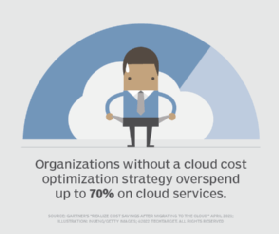
carloscastilla - Fotolia
Improve cloud performance with these 6 techniques
Boost the performance of enterprise cloud applications with the right mix of services and design choices. Consider these elements to optimize your workloads.
Enterprises strive for optimal application performance, but achieving it is no accident.
In an on-premises, host-based IT setting, enterprises must deliver properly tuned resources to meet performance goals. Cloud computing complicates these considerations because it limits how much a user can tailor the infrastructure and other available features.
While there is no single cloud architecture that guarantees peak performance for every application, several services and practices can boost cloud performance.
1. Select appropriate instances
Organizations see a profound result if they understand their workload's resource needs and provision an instance type with appropriate characteristics for it. VMs are the most common instance type in the cloud, though container variants are proliferating quickly.
The goal is to right-size the instance with the best allotment of virtual CPUs (vCPUs), memory and specialized characteristics. If the instance is too big, the extra resources have little benefit on the cloud workload performance and will ultimately waste money. If the instance is too small, it will impair performance -- if the workload runs at all.
Cloud providers offer myriad instance types -- each with a unique mix of vCPUs, memory, storage and networking. These VMs can be tailored for specific tasks. For example, AWS' A1 instances suit scale-out and ARM workloads. On the other hand, M4 instances balance resources for different applications. There are cloud instances optimized for compute-intensive workloads, memory-intensive applications, AI and more. This array of choices makes it essential to pick the right one.
2. Implement autoscaling services
Enterprises traditionally approached scaling as an ad hoc effort. Since the IT resources were limited and within the business's ownership, there was little need to make scaling fast, dynamic or autonomous.
However, public cloud computing is dynamic. The public cloud offers the potential to add or remove instances and related resources on demand. AWS, Google Cloud Platform (GCP) and Microsoft Azure each offer load balancing and autoscaling.
Organizations must implement the appropriate rule set to decide when and what to scale if they want to enhance cloud performance. In many cases, monitoring services track load characteristics, such as average vCPU utilization. When the workload exceeds a defined utilization threshold, the monitoring alert triggers the autoscaling service, which follows a predefined plan to add resources and set load-balancing preferences. When the load drops below a certain threshold, the autoscaling service can reverse the process and withdraw unneeded resources.

When implemented properly, autoscaling seamlessly maintains the performance of a workload for users -- such as its responsiveness -- while also managing cloud costs.
3. Implement caching services
Applications require data, but accessing storage can slow responsiveness -- especially when the resources are remote or congested with multi-tenant access. A cache is a copy of frequently accessed data placed in the fastest possible storage, located as close to the application as possible. The application can execute tasks involving data much faster with cached information than if it had to wait for the data from regular storage. Cache services available in the cloud include Azure Cache for Redis, Amazon ElastiCache and Google App Engine Memcache.
Since the cache itself is a data copy, it can cause problems if the original data changes. App developers need to plan how to expire and update cache contents to ensure continuity between the principal data store and the cache. Cloud providers offer ample documentation and reference architectures to help with the design process.
4. Adopt microservices architectures
Monolithic applications encapsulate the major features and functions within a single executable structure. This is a tried-and-true software development approach, but monoliths can pose challenges with scalability and performance in the cloud. When a traditional monolithic application reaches its performance limit, a completely new instance of the entire application has to deploy.
Microservices break applications into a series of interrelated programs that are individually deployed, operated and scaled. These independent services work together through APIs to provide the application's features and functionality. Thus, when one service is taxed to its performance limit, only that service must scale out. It can be a much faster and resource-efficient way to manage a modern application.
Microservices components can be deployed to small VMs, but it is common to instead rely on orchestrated container platforms, such as Azure Service Fabric.
5. Adopt event-driven architectures
Serverless computing has gained significant traction with developers, and event-driven architectures can run on serverless cloud services, such as AWS Lambda, Azure Functions and Google Cloud Functions.
Although servers are essential for operating event-driven functions on the back end, the idea is to avoid the deployment and long-term operation of traditional VM or container instances. Instead, the enterprise developers load code for certain software behaviors or functions into the cloud platform, where it only deploys and runs when triggered by some real-world or programmatic event. Once the function is complete, it is unloaded and no longer consumes cloud resources. The cloud provider -- not the user -- loads, operates and unloads the function.
While few applications are entirely event-driven, developers can use functions to create highly efficient responses to real and software-based events, such as IoT data streams. As a result, the overall software application can be smaller, simpler and better optimized for performance thanks to a serverless component.
6. Select a monitoring service
Never overlook the importance of monitoring when optimizing cloud performance. Public cloud providers offer an assortment of monitoring services, including Amazon CloudWatch, GCP Stackdriver Monitoring and Azure Monitor.
Even though monitoring has no direct impact on workload performance, these services are a crucial element of any deployment in the public cloud. Monitoring is the only objective means to track performance metrics, which provide the basis for decisions on services such as autoscaling and help organizations ensure their cloud investments yield results.







